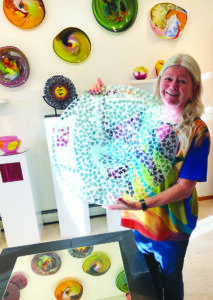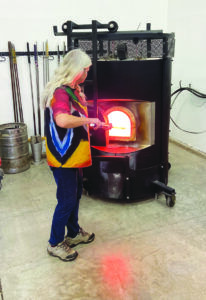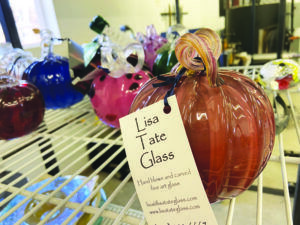
by Victoria Howell
Lisa Tate was always an artist but she didn’t start out as a glass blower. She was an engraver, mostly engraving on cut crystal. But she always loved cameo glass, also called Roman glass. According to Wikipedia, cameo glass is a luxury form of glass art produced by cameo glass engraving or carving through fused layers of differently colored glass to produce designs, usually with white opaque glass figures and motifs on a dark-colored background. The technique is first seen in ancient Roman art of about 30 BC, where it was an alternative to the more luxurious engraved gem vessels in cameo style that used naturally layered semi-precious gemstones such as onyx and agate. Glass allowed consistent and predictable colored layers, even for round objects.
Tate wanted to learn how to make those beautiful pieces. She tried to buy glass blowing blanks from other glass blowers, but there were too many flaws in the glass for the type of work she wanted to do, she said. “I got frustrated,” she said. “I realized I needed to learn how to blow my own glass.”
She took a two-week class at which the instructor told her it takes about 10 years to become proficient at glass blowing. Tate continued doing it for fun, and 10 years later, “I’m actually pretty good,” she said.
Tate grew up in Missoula and always planned to move back after years of having a glass blowing studio in Boise, Idaho. A couple years after moving back to Montana, she was able to buy her Florence home and set up a shop with state-of-the-art equipment, based on the knowledge and recommendations that master glass blowers have shared with her over the years.
Tate has a background in non-profit management and is currently the full-time Director of the National Museum of Forest Service History in Missoula. She is just completing a capital campaign to raise $10.5 million to build a world class facility. She is also a member of Artists Along the Bitterroot.

Tate says that glass is actually a liquid. The raw glass comes in bags of clear powder or cullet (which looks like small flat stones). The glass is slowly heated up to its liquid form and kept “idling” at about 2075 degrees. The furnace or “glory hole” heats it up to 2100 which is the right temperature to work with it. It’s removed with a “pipe warmer.” The uncolored glass has an amber color and is the consistency of warm honey. As the glass cools, it hardens and becomes colorless unless colors have been added. When the glass is the perfect temperature, glass blowers blow through a pipe to form a bubble-like piece that can end up as a cup, a glass, a bowl, a vase, a Christmas ornament, or a pumpkin! Every fall, Tate creates her own “pumpkin patch” of blown glass pieces that she loves to make and have become very popular. The finished pieces are put in a kiln at 950 degrees where they sit while they slowly cool down.
Tate said that the process of fashioning the hot glass into a piece of art happens very quickly, taking from five minutes to an hour, depending on the piece.

Tate gives classes and will show her work by appointment. Her shop is not a business storefront, so people should call her at (208) 484-6667 if they would like to visit.
However, there will be an open house and holiday sale at Lisa Tate Glass, 21718 Kesa Lane, Florence, on Saturday and Sunday, December 4th and 5th, from 10 a.m. to 2 p.m. This event is open to the public and everyone is welcome to stop in and see Tate’s work, which ranges from delicate Christmas ornaments of all colors, to vases and patterned Cameo glass bowls. Every piece is unique. Tate’s sister will also be showing and selling from her extensive collection of vintage jewelry. You won’t want to miss it.